This week’s CometWatch entry from Rosetta’s NAVCAM was taken on 15 May 2016 when the spacecraft was 9.88 km from Comet 67P/Churyumov-Gerasimenko.
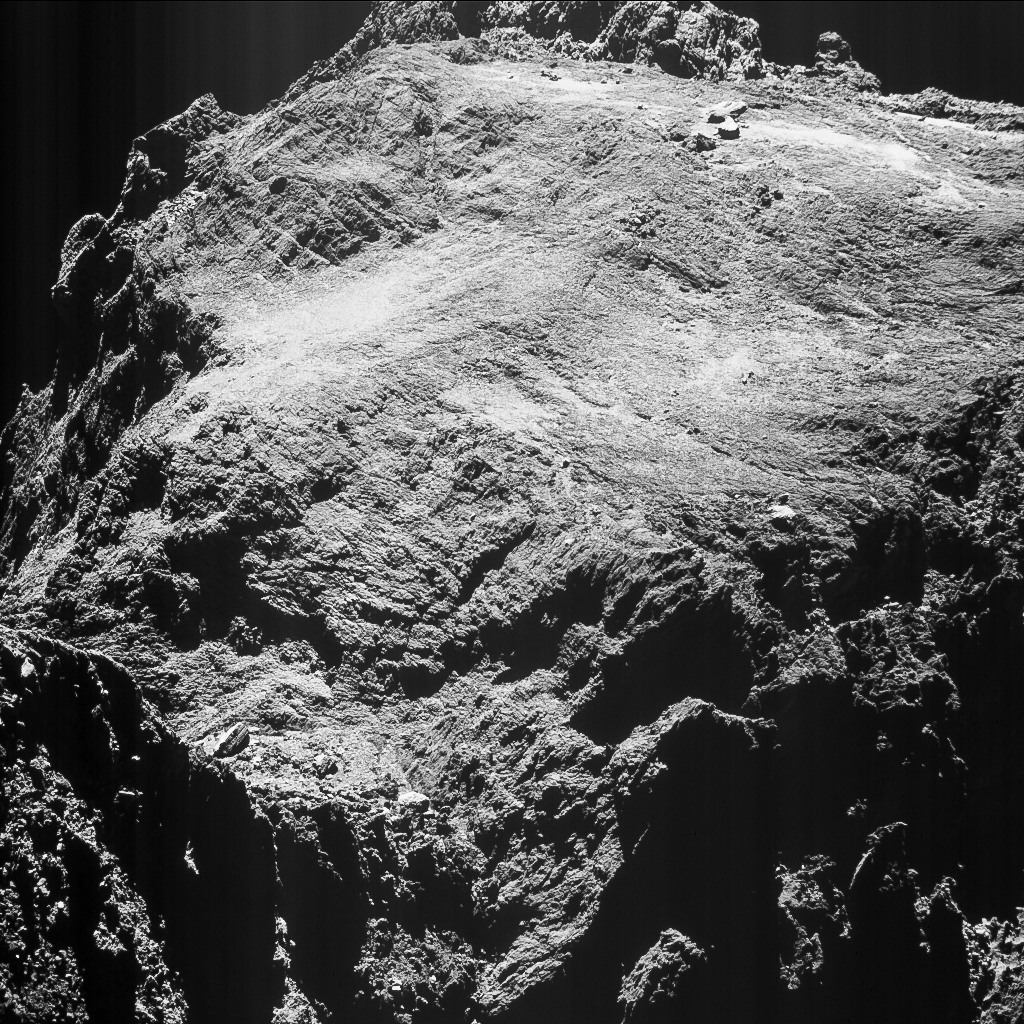
Enhanced NAVCAM image of Comet 67P/C-G taken on 15 May 2016, 9.88 km from the nucleus. The scale is 0.84 m/pixel and the image measures 862 m across. Credits: ESA/Rosetta/NAVCAM – CC BY-SA IGO 3.0.
This impressive close-up captures the relatively flat regions of Aker and Khepry on the comet’s large lobe. These regions are characterised by distinctive layers and in places cross-cutting fracture lines – these are particularly visible in the exposed faces at the top left. A number of large boulders can also be seen sitting within an island of smoother terrain towards the top of the view.
The small comet lobe lies to the bottom left of this view with the ridge-like feature separating Sobek (foreground) from Bastet (behind and out of view). A small portion of boulder-strewn Hapi can also be seen at the foothill of Aker. The largely shadowed region to the lower right marks the transition to Anhur.
With Rosetta currently at these close distances the OSIRIS cameras are also capturing stunning details of the comet.
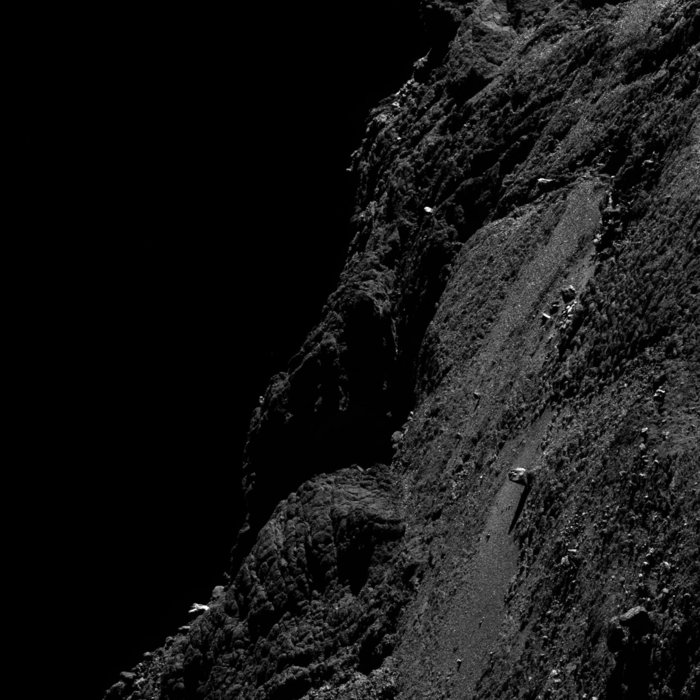
OSIRIS narrow-angle camera image taken on 11 May 2016, when Rosetta was 9.97 km from Comet 67P/Churyumov–Gerasimenko. The scale is 0.16 m/pixel. Credits: ESA/Rosetta/MPS for OSIRIS Team MPS/UPD/LAM/IAA/SSO/INTA/UPM/DASP/IDA
The image above shows fracture patterns similar to those seen in this week’s NAVCAM entry, but on the comet’s small lobe, in the Wosret region.
Two additional views released this week capture parts of the Imhotep region on the large lobe.
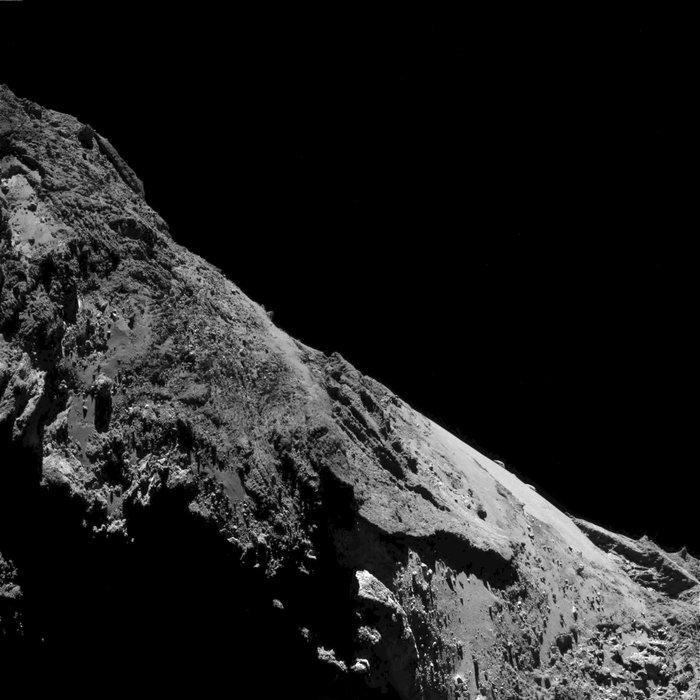
OSIRIS wide-angle camera image taken on 17 May 2016, when Rosetta was 9.4 km from Comet 67P/Churyumov–Gerasimenko. The scale is 0.89 m/pixel. Credit: ESA/Rosetta/MPS for OSIRIS Team MPS/UPD/LAM/IAA/SSO/INTA/UPM/DASP/IDA
The beautiful oblique view (above) shows the wider region – and was imaged by the wide-angle camera – while the close-up (below) was taken by the narrow-angle camera.
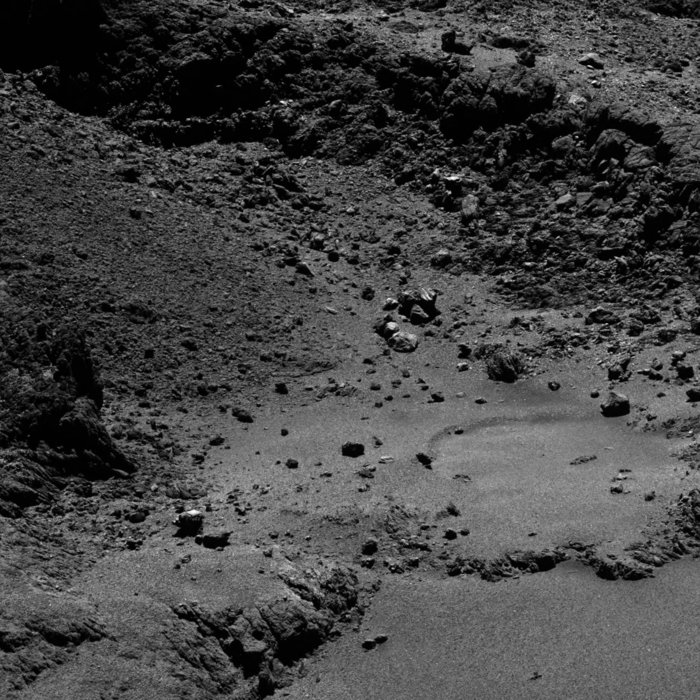
OSIRIS narrow-angle camera image taken on 11 May 2016, when Rosetta was 9.9 km from Comet 67P/Churyumov–Gerasimenko. The scale is 0.16 m/pixel. Credit: ESA/Rosetta/MPS for OSIRIS Team MPS/UPD/LAM/IAA/SSO/INTA/UPM/DASP/IDA
The close-up captures boulders of a range of sizes, likely associated with erosion from the surrounding slopes. The transition from these eroded regions on the outskirts of Imhotep to the central smoother plains is nicely highlighted in this scene.
The original NAVCAM from today’s release is provided below:
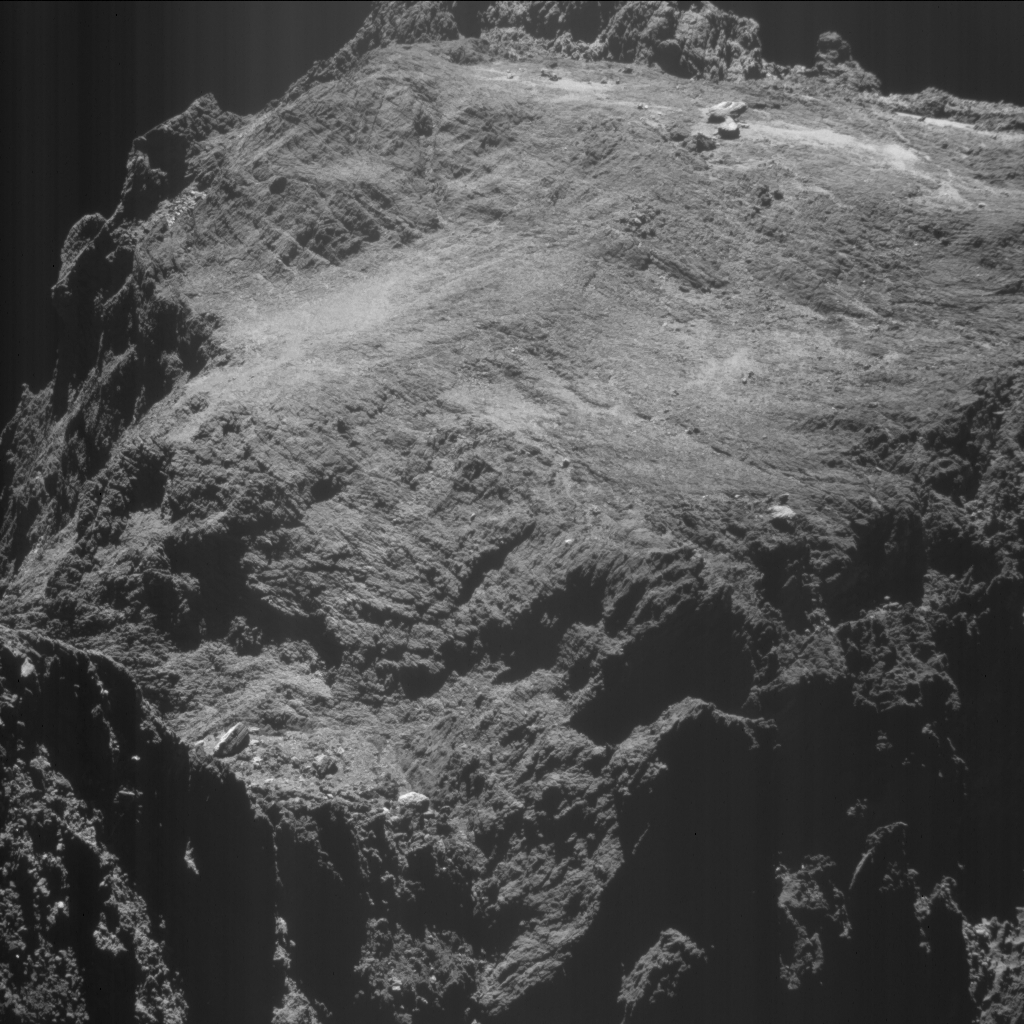









Discussion: 28 comments
Just pointing out that the third photo down is mirror-flipped. I thought this might be useful info because the first time I saw a mirror-flipped photo it caused me some confusion. Not many of the OSIRIS photos are published in mirror-flipped form and only one other has appeared on the Rosetta blog, which I pointed out as well.
I’ve done a page on the morphology evolution in the fourth photo down (the second OSIRIS NAC photo) according to stretch theory:
https://scute1133site.wordpress.com/sliding-in-western-imhotep/
As usual, I’ll emphasise that stretch theory isn’t supported by the mainstream and this is non peer-reviewed work.
Though by no means convinced, I am finding it increasingly difficult not to concede the merits of a lot of your proposed theory. I myself have spotted many possible fracture plains that appear to match between the two lobes. My problem is finding a mechanism to produce such “stretching”. Having little knowledge and understanding of this process I can not put forward any sort of argument for or against. So as is my usual MO, I will speculate and try to paint a plausible, if not scientifically rigorous, picture of a possible scenario for everyone to cogitate upon.
The premise as I understand it is that at some point in the past 67P needs to have experienced some event that caused the rate of rotation to increase significantly over a very short period of time. The suggestion that asymmetric outflow could be the cause is a possibility, but what might cause this?. The most likely reason would be a large change in orientation of the spin axis or orbit. This could be from gravitational interactions, but these I think would not result in the sudden and dramatic change required. A perhaps less plausible, but probably more likely instigator would be an impact. Relative velocities of objects hurtling around the inner solar system are massive.
Imagine that a rocky asteroid with an average density of around 3 times that of water ice were to strike a tangential blow to the outer edge of the comet with its density only being just over half that of water ice. The comet is very porous and so relies for much of it’s structural integrity on the thin crust of sintered ice making up the top few metres of its surface. Think “Malteaser”. That hard, dense rock carrying humungous amounts of Kinetic Energy, is going to slice through the comet like a hot knife through butter, making a large chasm on one side and at the same time changing the axis and rate of rotation. Quite possibly this could also result in an almost instant change in the orientation of the sunlit hemisphere. Suddenly the cold dark Winter hemisphere covered in condensed volatiles is instantly exposed to a huge change in energy flux and the required asymmetric outgassing would ensue.
We now have a more rapidly rotating comet, that speed of rotation being added to by the sudden and vastly increased outgassing from one hemisphere leading possibly to the postulated stretching. Already weakened by the impact in one region this could end up with the one body splitting into two. The material outflow from the two different sized pieces would mean their spin rates would be slightly different. The likelihood is that gravity would pull the two pieces back together and the resulting collision could well then appear to make the comet appear as a contact binary, but with the two lobes no longer in the same alignment as if they had been “twisted”. Certainly right from the very first large scale images it was very evident that some form of collision had created stratification by compression waves passing through the object. A few, including myself, pointed this out very early on.
These two collisions inevitably generate considerable heat and pressure. Conditions suitable for aiding the formation of Clathrates, possibly producing temporary melting of surfaces, seismic activity or Cryovulcanism. All of which there appears to be some evidence for. Then there is the enigma that is the comet neck. Could this be the chasm gouged out by the passing lump of rock. The lump of rock may have only been a few tens of metres across, but the initial heat from the impact and subsequent differential erosion of the valley created, could possibly result in the lopsided erosion seen in the neck region today.
OK, so its a long sequence of possibles and suppositions, but any postulated theory has to fit as much of the known evidence as possible however preposterous it sounds. I give you the formation of the Moon or the rock deficient mantle of Mercury, the axial tilt of Uranus, each one now quite widely accepted as being the result of large impact events. A comet that regularly traverses the region of the main asteroid belt is going to have a very significant chance of being hit by a small rocky body I would reckon, so this scenario is by no means unlikely.
Thats my latest two pence worth anyway. Should keep us all going for a few weeks arguing the pros and cons. I’m not sure even Logan’s mental meanderings can top this, but it may ring somebodies bell to enable them to uncover a bit more of the story. The truth is we can only ever speculate and eventually go with the most plausible scenario that fits the evidence and the available models the best at the time. Your Honour, I rest my case.
Following all of You 🙂
Robin
See my reply under your other comment below. It should be for this one
Hi Robin,
I am taking a different tack and am looking for “Mid Atlantic Ridges” in the form of evolution of the neck shape evidenced by positions of boulders near Anuket’s “neck crack” before and after perihelion. If stretch occurred, it could be happening through perihelion some more.
https://marcoparigi.blogspot.com.au/2016/05/anuket-neck-crack-after-and-before.html
Should be four images after perihelion and three before. Not sure if people see what I mean…..
With these marvelous ever more detailed pictures would there be a chance later to discover the whereabouts of Philae ?
Hi Simon.
I am afraid you are likely to be disappointed. Having trawled through a large percentage of the images and studied those covering the Abydos region closely, I have come to the conclusion that Philae now lies buried under layers of ice boulders. The small search area defined by CONSERT data and other flight information now has a completely different appearance to that of November 2014. Superficially it is seems similar, but specific features, gullies and niches are now erased by “Cryorock scree”. Since one of these depressions was the likely final resting place for our robotic hero, the chances of Philae having avoided entombment are very slim.
Lumps of frozen comet stuff tumbling into or landing on Philae, knocking out solar panels, radio transmitters or moving the probe, would seem a plausible explanation for the loss of contact scenario last Summer. The “Legend of Philae” will no doubt grow and future generations may think it worth a manned mission to find our intrepid mechanical pioneer, I do hope so anyway.
Hi Robin
Thanks for your input. I won’t weigh in right away. Let’s see if others do. Meanwhile, I’ve updated the page I linked above with a new photo at the end. It shows the rift line as being more obvious than it is in the header photo.
By the way, have you posted any photos of the Philae location with your thoughts on your site? Is it Instagram? I thought I’d visit as I do from time to time but couldn’t find it with a quick search. I’m sure I will if I search a bit more diligently later.
Sorry, I was wading through the thousands of recently released images. The different lighting and viewpoints reveal more of the area previously in the shadow of the cliff below “Malmers Glint”, which still seems to be there, in fact it “appears” to have grown larger. As we have all seen, such different viewing conditions can make familiar areas appear quite different. Whereas before there seemed to be a number of niches, alcoves and gullies, a couple of which I thought could have been possible sites for Philae’s final resting place, the area appeared to be more uniform, covered in boulders and those gullies no longer visible. Viewpoint, lighting or resurfacing could all be explanations, I speculated on just the one possibility. Since we don’t know where Abydos actually is, Philae could still be “above ground”.
No I don’t have my own blog or anything other than a Flicker page. I am, in general, a Luddite when it comes to the internet. This is the only blog I now take any part in, more as an enthusiast and informed layman than serious science contributor. I got hooked and 67P still intrigues me. I just enjoy the chance to take part and many thanks to the ESA outreach team for all their efforts to make that possible.
Hi Robin Sherman,
Where are these images of Abydos? I have struggled to see any with enough resolution to make any such conclusion. If you do have some, I would be ever so grateful for you to mention links to them.
Simon,
I think, we can be rather sure, that the Rosetta team will try to identify Philae, or at least the location it has been after landing.
Knowing Philae’s exact position for sure would improve at least the interpretation of CONSERT data. So this attempt will be justified by science return.
In addition Philae’s cameras took close-up images. Context images from a larger distance and from different angles would improve the interpretation of the close-ups.
Those additional post-perihelion images may also reveal changes, and help constrain surface material properties.
Similar arguments apply to Philae’s first touchdown location.
If Philae’s position changed after final touchdown, this could give some hints about local surface activity.
And from a technical point of view, it would of course be interesting, how Philae’s state appears from an outside view, whether his solar panels are covered with dust or debris, or whether there occurred any obvious damage.
Any experience of this kind could help improve future missions to comets.
I’m puzzled.
The last three images are all labelled as Osiris narrow angle camera, all at 9.x km, very similar distances.
But two give scales of 0.16m/pixel, whilst the other is 0.89m/pixel.
This seems inconsistent.
Whatever, stunning images.
I’d love to know whether the detailed radio science measurements etc of the orbit are likely to reveal much about the internal mass distribution. At distances as short as this, maybe – but I’d guess it’s a very difficult ‘inverse problem.’
Apologies, I had erroneously labelled a wide-angle camera image as a narrow-angle camera image – corrected!
Beautiful as always….
Great work team. Boldly go!
Surely layering requires deposition in a marine environment.
Hi Henry. Deposition of dust at some forgotten corner of your house|app; Of ice at the top of cold mountains… Most of the layering you see every day is not there by deposition.
Emily: It’s not the small lobe but the large. On the small lobe we all want to know what you see of the area around Philae.
Oops, yes of course it is the large lobe, thanks!
Is the “pebbled” appearance of the surface due to the “goosebumps”? If so, they seem to be more available on this flattened face than elsewhere.
Hi Kamal
I’ve tweaked this latest OSIRIS image to show the surface of the comet in detail. Taken from only 7.7Km above the surface it shows amazing detail and it can be seen just how much the surface resembles a shingle beach. Zooming in reveals lots of tiny gas plumes emerging from all over the surface, but particularly in the “pebble” covered areas. They can be seen by the “mirage” effect created by the slight difference in the refractive index of the gas compared to the surrounding vacuum. Most plumes are just a metre or two in height, but a few are several metres tall. The surface is still active, but resembles the slowly smouldering aftermath of a forest fire rather than the raging inferno we saw from hundreds of Kilometres away after perihelion.
https://www.flickr.com/photos/124013840@N06/27125175182/in/dateposted-public/
The resemblance to the scree slopes of mountains is clear, the effect of erosion by thermal stress being most likely a common mechanism. Some of the larger “Cryorocks” seem to have been transported to their current resting places and could be “coma fallout” or “hailstones”. The large number of different textures and sizes of these “Cryorocks” also suggests they have come from widely differing parts of the comet. Even the local native terrain shows considerable variations in grain shape, size, texture and appearance, perhaps rough and ready evidence for an accretion scenario of planetesimals of slightly varying composition. One would suspect that the heat generated during such a process would locally “fuse” material together, also added to that is compaction by the pressure of thousands of metres of material deposited on top as the comet grew in size. The surface of the comet we see now was once many Kilometres below the surface.
While exposed on the surface rapid freezing and sintering would create a hard crust limiting such consolidation and possibly creating “dinosaur eggs’ or “goosebumps” analogous to lumps of pumice created from molten rock rich in volatiles. The extent of that hardening would depend upon the changing solar illumination as the topology of the growing comet’s surface changed. Now we see that as “nodules”, outcrops and cliffs as the more volatile material, darker, organics rich material, or less consolidated areas, erode faster. The whole comet could be a partially “fused aggregate” of “pumice like” lumps of volatile ices. Between these larger “lumps, might be a loosely packed matrix, due to sublimating gases keeping surfaces very slightly separated, of smaller ice particles, dust and organics, which is more readily eroded. Hence, the unusually low density of the comet overall.
Of course the true explanation could be totally different, but it seems a reasonable extrapolation from basic principles to me. Rock and ice are both crystalline solids, so the same physical processes acting on them are likely to produce very similar outcomes, visually anyway. Its not surprising therefore that the comet does “appear” amazingly like it is made of “Rock”.
Great Observations, Robin 🙂
Robin: Nice to see you back on the debates. Your suggestion is that sunburnt Aker on the large lobe, seen by Navcam here at 0.84 m per pixel, will eventually resemble the “shingle beach” at Agilkia on the small lobe when viewed by Osiris at 0.13 m per pixel, and that we saw earlier from even closer up from Philae. On another 0.16 m per pixel OPOD of Wosret (?) on the small lobe taken on 11 May, one may hypothesize that there is a continuity between the “sandy” appearance on the right of the image and the “rocky” appearance on the left hand side. It is an attractive hypothesis because it reduces everything to one mechanism powered by the Sun.
Comet Scientists are a special kind of Meteorologist 😉
However, this celestial view is dominated by bodies that are less than one millionth of a meter. In one drop of seawater, there are about one million heterotrophic bacterioplankton
The temple of the hieroglyphs 🙂
https://www.esa.int/spaceinimages/Images/2016/05/Comet_on_15_May_2016_NavCam
Not letting it go without saying that
https://www.esa.int/spaceinimages/Images/2016/05/Comet_on_15_May_2016_NavCam
is a true artwork on edge post-production.
Congratulations to the Team.